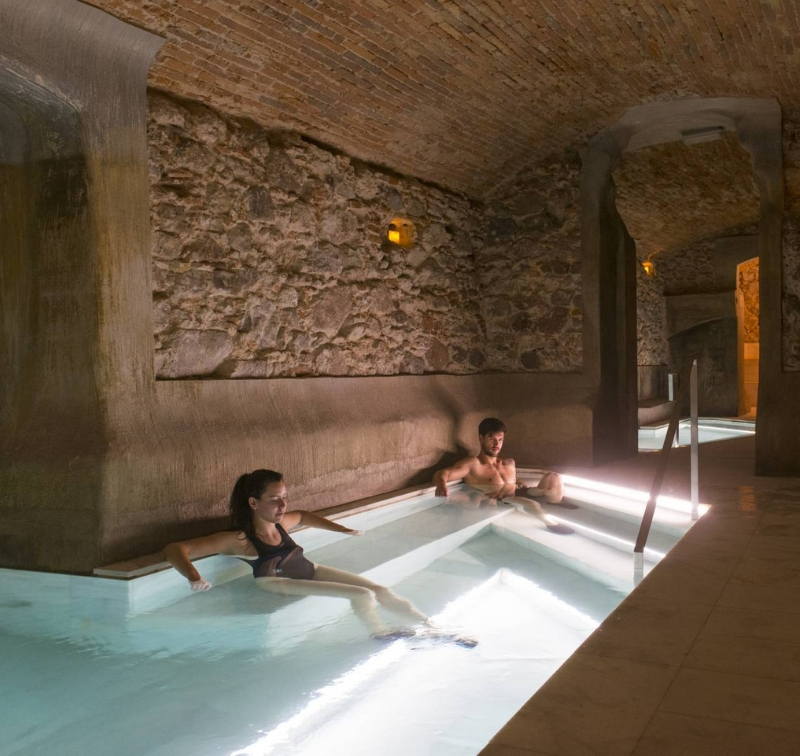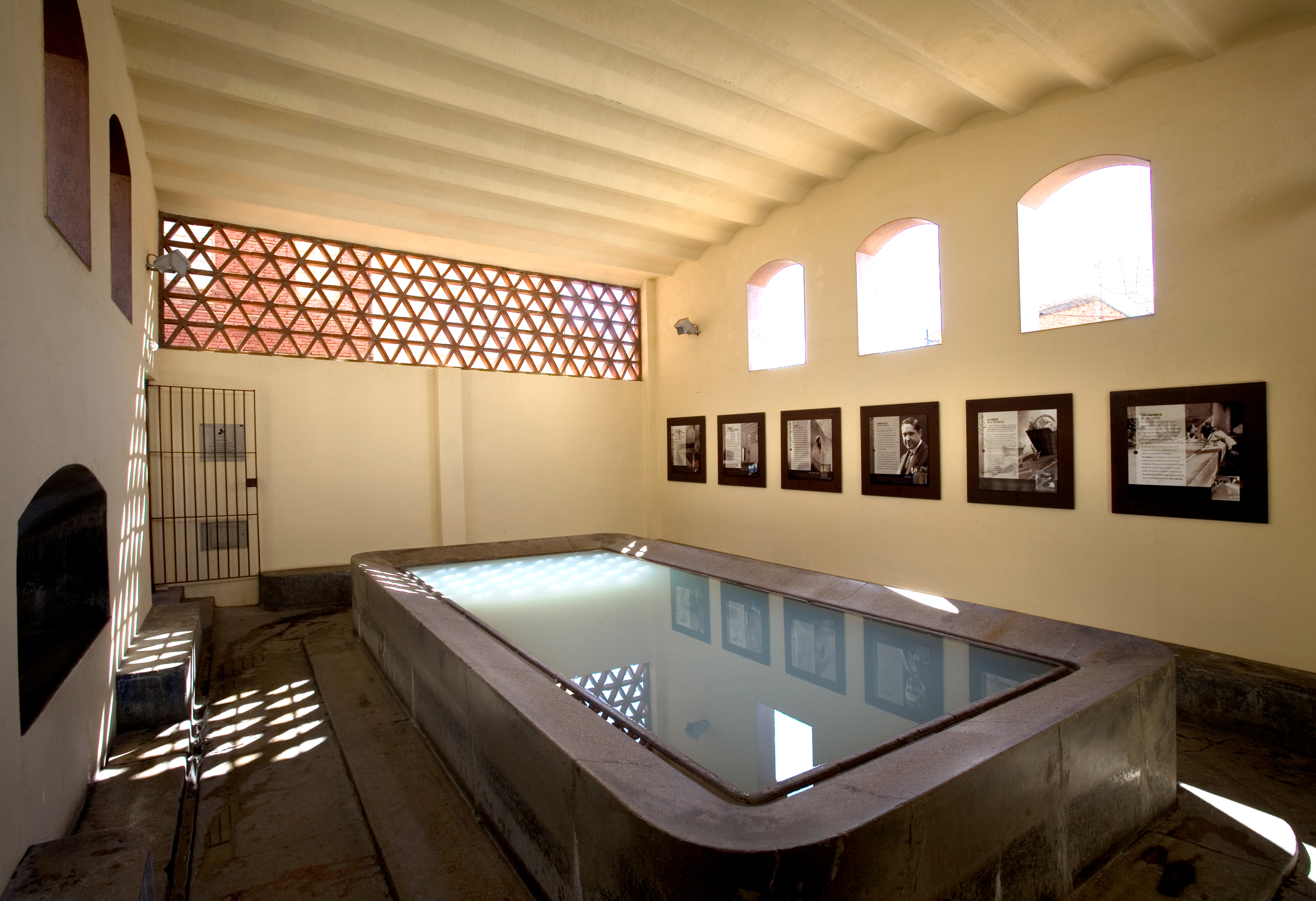This appeal is complemented by other attractions which make the spa town a cultural, sportive, nature and tourist resort. Its good geographical situation, a mild climate and waters that gush out at 74º C, one of the highest temperatures in Europe – has shaped the history and life of this town with a population of more than 17,000 inhabitants.
If we take a short walk through the characteristic streets of the old town centre, we can follow the historical thermal itinerary in which we will come across the ancient roman baths, the symbolic Font del Lleó (Lion Spring), the communal washing houses which are supplied with hot spring water, the parish church of Santa Maria and the spa hotels.
The itinerary also includes a visit to the museum Thermalia and the traditional house-museum of the Delgers. Continuing on our way and just outside the old town centre we can admire the unusual Romanic bridge and the chapel of Remei.

Thermalia
Historical Background
When the Romans arrived in the Vallès, they were immediately attracted by the curative properties of the hot spring waters that gushed out at this spot. From those Roman times the town of Caldes de Montbui became a spa resort and from there has developed into an important urban centre.
The remains that we can admire today constitute one of the few Roman spa settlements that have been preserved in Europe and have been designated as a Cultural Heritage Site of National Interest.
The roman baths of Caldes de Montbui were medicinal and there was a set of areas dedicated to different treatment therapies, along with a range of activities related to hygiene and leisure.
The thermal pool which can be seen today is only a part of the great complex of thermal baths which existed in Roman times. This extended over the old hospital (now Thermalia), the spa hotels of Rius and Broquetas, and the present square of the Font del Lleó. Up to now, eleven areas of the Roman bath complex have been located, although it is possible that many more remain to be found.
The ancient Roman Baths illustrates two millenia of Spa Tradition
Documents from the 17th century confirm that the spa tradition in Caldes is very old. In the first half of the 19th century, Caldes de Montbui was the leading spa resort in Catalonia and the second in the peninsula in terms of number of establishments and their quality.
The waters
Springs & Spas
The Font del Lleó (Lion Spring) is the most well-known hot spring in Caldes de Montbui. It is situated in the square which bears its name, in the middle of the old town centre. The water emerges at a temperature of 74º C, one of the highest in Europe. The Font del Lleó was built in 1581 and was renovated in 1822. In spite of the reforms, the gargoyle and the base wall have been preserved over the years..
The spring we can admire today dates from 1927, the year in which it was restored and improved by Manuel Raspall, who gave a “noucentist” character to the present monument, with the lion which gives the spring its present name, and has become the symbol of the town.
The water is then redirected to the “safareigs públics” (communal washing houses), constructed in the 19th century and still in use to this very day.
As well as testing the powerful effect of the thermal waters for themsleves, visitors have the chance to break with everyday routine, get fit, become acquainted with an area of total peace and tranquillity and restore their necessary energy. Caldes de Montbui is the ideal setting for refocusing, while enjoying the sensations offered by its mineromedicinal waters, its history, culture, and nature..
The expansion of spa activities started in the second half of the 19th century and continued to its present level. In that time a series of comfortable buildings were constructed in the style of those in prestigious Europoean spa centres, designed not only to take advantage of curative effects of the waters but also to offer a place for recreation and rest to their guests.
All of these establishments have been modernised whilst maintaining their characteristic modernist features. Consequently, there are now a considerable number of establishments open to the public, helping Caldes de Montbui to keep its position as the leading spa resort in Catalonia.

Springs
The Font del Lleó
Earliest known use
II BD
Hottest Spring
74ºC
Culture & Gastronomy
More than water
Through its permanent exhibition of the international artists Manolo Hugué and Picasso, Thermalia forms the thematic heart of spa culture. It also displays the treasures, the history, the personalities and the traditions surrounding the water which gushes out at 74ºC and which has shaped the origins and personality of the town.
The visit to the museum proposes a tour based on the thermal experience itself. By means of an absorbing and attractive interactive exhibition, the visitor can enjoy discovering other aspects of thermalism through personal experience. Two of the four floors of the museum cover the life of Manolo Hugué and leads us into the world of 20th century art, including the genius Picasso, represented in an exhibition of a very personal nature: the fruit of the great friendship which united the two artists.
The city has many cultural places forth the visit, among them: The Casa Delger (Romantic Museum) shows thelifestyle of the 18th Century, the Church of Santa Maria with the Santa Majestat carving, the Prison Tower designated Cultural Heritage Site of National Interest, the Romantic Bridge, or the Chapel of Remei…

